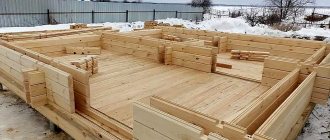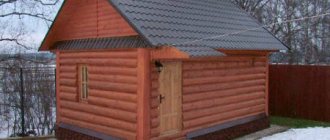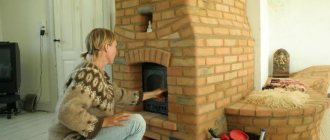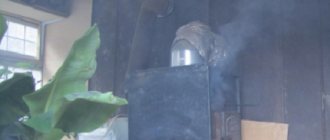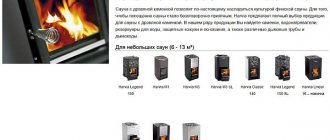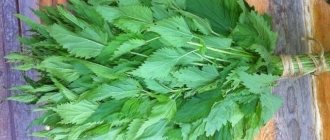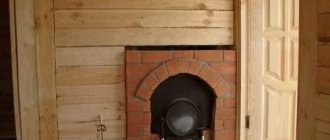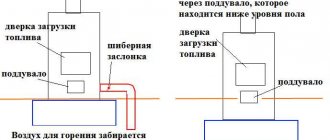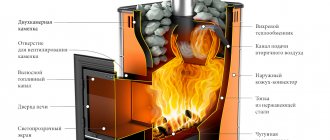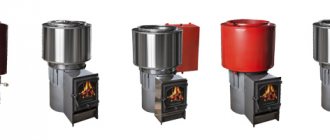Metal stoves for steam rooms, assembled from stainless steel, require virtually no maintenance. Painting an iron stove in a bathhouse is necessary due to the conditions in which it is located and the characteristics of the material. The article describes the requirements for paint coatings, provides advice on surface preparation, and lists trusted manufacturers.
Is it necessary to paint a metal stove in a bathhouse?
A metal sauna stove is susceptible to:
- corrosion;
- thermal expansion;
- burnout.
The first occurs from exposure to water and steam, which leads to the appearance of pockets of rust that destroy the walls of the structure. Temperature deformations are caused by heating and cooling of the stove in the bath. As the metal expands, cracks form in weakened areas or become thinner. The temperature in the furnace rises above 600 °C, which is why the grates and walls burn out over time. Painting a sauna stove will extend its service life and improve its appearance.
Criteria for choosing the right paint
The choice of paint is influenced by the metal from which the stove is made. Iron without impurities heats up and deforms more strongly than refractory compounds. To extend the service life of the material, compositions with maximum heat resistance are used. Their cost is significantly higher than that of acrylic paints. It is not profitable to buy an expensive composition for a stove made of low-quality metal.
Expert opinion
Zakharova Irina Yurievna
Cleaning professional with 15 years of experience. Our best expert.
Ask a Question
Cast iron is a more suitable material for sauna boilers and stoves. It heats up to a temperature of 350 degrees, with a maximum firebox of 500 degrees. Heat-resistant acrylic paints are suitable for painting a cast iron stove.
The choice of paint is influenced by many factors: type, properties of the metal, atmospheric features and composition requirements. To make it easier to decide, there are four main criteria.
Heat resistance
The concept includes:
- heat resistance - long-term absence of deformation under constant exposure to high temperature;
- heat resistance - the coating remains uniform and does not change color from extreme heat.
In paint for metal stoves, the first quality should prevail over the second. Heat-resistant compounds are suitable for brickwork with a maximum heating temperature of 90 degrees. The coating on the metal in the bathhouse experiences increased stress from temperature changes. Therefore, it is preferable to use elastic and durable paints that can withstand heating and subsequent cooling.
Corrosion protection
To prevent rust, you should choose paints that form an airtight film. Through the vapor-permeable coating, droplets reach the metal surface, which eventually leads to corrosion.
See also
Types of wood paint removers and how to use removers
Water repellent properties
Metal paint should keep water and condensation out. Polyurethane compounds cope with this task.
Safety
The paint for heating devices must not contain toxic substances. Otherwise, the room will be filled with toxic steam.
How to paint an iron stove in a bathhouse
When choosing paint for a stove in a bathhouse, they are guided by the following requirements:
- heat resistance;
- neutral to moisture;
- environmental friendliness;
- anti-corrosion properties.
It is important that the coating is resistant to the required temperature range. The latter ranges from 300 °C. This indicator is with a reserve, since the heating of the walls is 200 °C and above. The surface around the loading hole is covered with fire-resistant paint, as it can withstand exposure to open fire. Make sure that the dried composition has elasticity. The stove is not heated every day, so amplitude changes in the microclimate affect the uniformity of the paint film.
The composition should not be water-soluble and contain chemicals that remain active throughout its service life. If this is not taken into account, then emissions from heating will poison the body, negating the benefits of visiting the bathhouse. The anti-corrosion properties of the composition are an important aspect that stops the appearance of rust.
Attention! Do not use regular enamel to paint the sauna stove. At a temperature of 80 °C, it swells, and when heated, it releases solvent components that enter the body through the skin and respiratory tract.
Painting procedure
Now you can start painting the potbelly stove. Before applying heat-resistant silicon-organic enamel, make sure that the prepared solution is not too thick. If you coat the surface with a viscous compound, it will not absorb well into the surface. In addition, such paint is quite difficult to work with. Therefore, first dilute it using a solvent specially created for organic materials. If you do not have such a solvent, you can dilute the paint using ordinary turpentine.
When the required thickness has been achieved, begin painting the potbelly stove. The paint should be applied in a fairly thin layer and wait until it dries completely. Then you need to apply a second layer. If the enamel lays down in an even layer through which the brick cannot be seen, you can complete painting at this stage. If the bricks are still visible, then you will need to apply an additional layer, and only after that paint the cast iron structural elements.
Paint for sauna iron stove
Thermal stability and fire-resistant properties of the paint are ensured by:
- silicone;
- oxygen;
- silicon base;
- aluminum powder;
- organic resins.
Some of these elements are contained in Thermal stove paint, which can be found under the Tikkurila brand. The shades of the composition are black and silver, because they do not accumulate, but immediately release heat from the heated walls. The base is alkyd resin. The manufacturer provides a 3-year warranty, during which the coating will not deform and will retain its appearance. Containers of 330 g are available for retail sale.
Heat-resistant compounds are produced by a Latvian manufacturer under the Hansa brand. The paint is supplied in containers for application with a brush and in aerosols. The second type of packaging is more convenient, because it is immediately ready for use and the surface is smooth. Available in 16 shades, each retains color when heated to 800°C. Suitable for use with stainless steel sauna stoves.
"Kudo" is a domestic company whose product range includes organosilicon-based enamels. Paintwork can withstand heating up to 600 °C and is supplied in aerosols with a capacity of 520 ml. Consumers appreciate Bosny products. The advantages of heat-resistant paints from the manufacturer: elasticity and resistance to fading of the pigment. Maximum temperature - up to 650 °C.
Fireproof paintwork from Hammerite is designed to withstand temperatures up to 600°C and is therefore suitable for use in saunas. The composition can be applied to a rusty surface, since there is a converter component. Use a roller or brush. Gasoline or kerosene, which affect the composition, is not suitable for degreasing. For greater heat resistance, choose a coating from Elcon. The paint can withstand temperatures up to 800 °C and sudden changes, does not burst or bubble. Supplied in aerosol cans with a capacity of 500 ml.
Of the available options, paint KO-8101 is used. The manufacturer provides a 15-year warranty on paintwork. If you want to choose a shade other than black or gray, purchase KO-8111. The enamel is environmentally friendly, without harmful emissions. The heat-resistant coating KO-8222 can be heated up to 800 °C. Cetra remains popular for painting iron sauna stoves.
Popular brands of paint for metal stoves
The best choice is considered to be organosilicate (or organosilicon mixture). It is labeled as KO, and the most popular is KO-8111. It has good performance characteristics and is inexpensive. Experts recommend CERTA paint because it is produced in the form of aerosols, which are most convenient to use. The service life of the coating exceeds 15 years.
Read further:
How to paint galvanized metal: an overview of paints and their characteristics
Pay attention to: How to paint galvanized metal: an overview of paints and their characteristics
Painting the inside of the microwave: what paint to choose, step-by-step painting instructions
How to degrease metal before painting: main selection criteria
Paints for heating radiators: types and varieties of compositions, popular brands of paints
Painting wallpaper not for painting: is it possible to paint paper wallpaper, what paint to choose and the technology of work
Painting the stove in the bathhouse
Before starting work, prepare the tools, location and surface of the iron furnace.
Necessary tool
For paint in cans, purchase a 15 cm wide roller or a brush with fine bristles. You will also need:
- metal brush;
- sandpaper;
- grinder with grinding disc;
- solvent;
- rags;
- newspapers or plastic wrap.
The grinder is used to speed up the processing of large surfaces. The roller and brush are replaced with a spray gun, provided that a compressor is available. Newspapers and plastic film are needed to protect walls and ceilings from drips and drips.
Surface preparation
Surface preparation depends on the condition of the metal and the type of paint composition.
- A dirty sauna stove is washed from soot with water and household chemicals. This will remove some of the fat.
- Large particles of rust are removed with a metal brush, walking along the edges. They do not achieve the shine of the metal.
- Using fine sandpaper, remove rust residue from an iron sauna stove and level the surface so that the paint lies evenly.
- Use a broom and a dry cloth to remove any remaining abrasive.
- The oven is washed, wiped and dried.
- The rags are soaked in a solvent and passed over all surfaces of the iron stove. After drying, blow off the lint or wipe it with a microfiber cloth.
Advice! If the structure has elements made of stainless steel or galvanized, then they are coated with grease to prevent paint from entering.
Applying paint
The perimeter floor and the walls near which the iron stove is installed in the bathhouse are covered with polyethylene or paper and the seams are glued together with regular or masking tape. Before painting, provide ventilation to avoid poisoning by solvent vapors. Use a respirator with carbon filters, gloves, goggles, a protective suit or old clothes.
After opening the bottle, stir the paint for 2-5 minutes to achieve a uniform consistency. This is necessary because during storage the suspension settles. If stove paint needs to be thinned, use solvents recommended by the manufacturer. For manual application, the composition is made thicker; for a spray gun, the thickness is reduced. The sprayer is filled through a filter, nylon stocking or paint sieve to trap solid particles that can clog the nozzle.
The surface of the iron furnace is visually divided into hard-to-reach areas and the main area. Large surfaces are treated first. Heat-resistant paint is applied in one layer, so the spray gun or roller moves smoothly. The speed is selected so that there are no drips left. After completion of the work, the room is closed, excluding drafts, which will cause dust and lint to settle on the fresh paint. A video of the dyeing process is below.
Application of Certa
Certa is a heat-resistant paint that is specially created for painting stoves. It is the best option to solve this problem. However, before using it, it is necessary to prepare the surface.
It is performed as follows:
- use emery to remove rust;
- where this is not possible (there is a lot of rust), it is necessary to use a rust converter;
- using a solvent of the P-021 series, it is necessary to thoroughly degrease everything
- oven surface (remove metal chips that remain after using emery).
Read also: What to make a room partition from
Now you can proceed to applying Certa. It is recommended to start with joints, protruding and hard-to-reach parts. It is necessary to paint in perpendicular lines.
Multiple coats are highly recommended. In this case, you can guarantee a complete absence of rust in the future.
What is the frequency of staining?
The manufacturer indicates the operating conditions and service life on the paint, so if they are observed, you can count on the established period. Bath stoves made of thin metal are often painted, since the walls heat up more, which leads to wear of the lacquer coating. Periodically, the enamel is inspected for damage to prevent rust. To eliminate the need for maintenance, the oven is made of stainless steel or galvanized.
Whitewashing, or Safety First
If safety is of fundamental importance in the question of what is the best way to paint a brick stove, opt for lime whitewash. The process itself is quite simple, but it is worth remembering that despite all the advantages, this material is not durable. Whitewash cracks under the influence of temperature changes, so painting will have to be done every year.
Of the nuances of using whitewash, it is worth remembering the following...
- Salt is added to the solution to increase wear resistance. In addition, this will save you from the problem of streaks appearing.
- It is recommended to sift the chalk through a sieve, and both water and milk are used for soaking.
- If after mixing the solution has a slightly yellow tint, it is worth adding blue to it.
Burnishing an iron stove
Burnishing is a method of giving a dark shade to an iron stove in a bathhouse without using paint. The surface is coated with an oxide that is resistant to moisture and temperature. At the first stage, the metal walls are cleaned with a brush, grinder or sandpaper until shiny, removing the oxide. Treat the device with a degreaser or solvent to remove any remaining abrasive and rust.
Prepare a solution in which 5 g of butyl alcohol and 150 g of phosphoric acid are added per liter of water. The composition is mixed and coated on the iron surfaces of the sauna stove. As soon as the metal is dry, it is washed with dissolved laundry soap. In order for the surfaces to acquire the desired shade, the oven is heated to 150 °C and caustic soda is sprayed from a spray gun. The cold method of bluing an iron furnace uses a mixture of olive oil and antimony III chloride. The composition is applied in two layers at intervals of 48 hours. The first layer is removed with a woolen rag.
Attention! When bluing, personal protective equipment for the skin, eyes and respiratory organs is used.
Lime painting preparatory stage
Rice. 1. Potbelly stove made of metal.
A potbelly stove can be made of metal. This design is shown in Fig. 1. The oven can also be made of brick. Stoves can be painted using different finishing materials. Thus, for finishing brick structures, an affordable and fairly high-quality material called lime is often used. To paint a potbelly stove yourself, prepare the following required materials, fixtures and tools:
- Brushes and rollers;
- Bucket;
- Solvent (can be replaced with alcohol);
- Enamel in aerosol;
- Lime;
- Water;
- Dyes;
- Glue.
Construction of a potbelly stove made of metal.
Before painting the potbelly stove, you need to prepare a solution suitable for this. Take a bucket or other container, add lime and fill it with the same amount of water. After this, mix the mixture thoroughly and add animal glue to it. You can purchase this glue at a store that specializes in selling various painting supplies. You will need relatively little glue - about 100 g per 10 liters of solution. Before you add glue to the lime mortar, be sure to dilute it in a separate container (an ordinary bucket will do) with a small amount of water.
To understand whether a lime-based solution is ready, you need to do the following: take a small piece of glass, fix it vertically and apply a little solution. If the paint spreads no more than 3 cm, then everything was done correctly, you can begin finishing the stove.
If you want to paint your potbelly stove not white, but some other color, then you will need to add a little dye to the solution. Potassium permanganate, blue or synthetic paints can be used as a dye. The specific option is selected depending on what shade you want to get.
Design features and characteristics
The “potbelly stove” appeared at the beginning of the nineteenth century. It was an expensive thing, it required a lot of firewood, and accordingly, only wealthy people could afford it. In Europe it was called a “metal stove”, and after the February Revolution in the vastness of our Motherland it was nicknamed a “potbelly stove”. Since then, it has been strongly associated with poverty, everyday inconvenience and devastation.
The original design was a metal cylinder or box standing on iron legs. The stove had a door and a chimney pipe. Simply to the point of impossibility, and therefore ineffective. If the fire went out, the walls of the oven instantly cooled down. To maintain an acceptable temperature, it was necessary to constantly add firewood.
But time passed, the design was improved and redesigned for various types of fuel, and the stove itself was given a noble appearance. So the “potbelly stove” began its victorious march and appeared in every second garage and every third dacha. It not only heated, but also cooked: on the surface you can boil a kettle and fry an omelette. Now this is no longer an ordinary pipe with a firebox, but a reliable heating device, which is also an interesting piece of furniture.
A potbelly stove can become the object around which the interior of the entire dacha will be built
A modern stove-stove for a summer house and garage copes with heating a room whose area is fifty to sixty square meters. The design itself has undergone significant changes. It contained:
- Slow burning mode. A special lock seals the doors hermetically and prevents smoke. Valves installed on the air intakes of the ash pit and door can regulate the air flow and combustion intensity;
- Flue gas afterburning system, which is installed in the upper part of the firebox. It increases efficiency and reduces the temperature of the smoke that enters the chimney;
- Heat-resistant lining of internal walls. For this, fireclay or other fire-resistant materials are used. They retain heat longer and protect the metal from overheating, thereby extending the life of the furnace;
- Heat-resistant glass insert. It is placed on the firebox door. In the evenings you can admire the fire.
The model is different, but as a class of heating equipment, potbelly stoves for a summer house and garage have a number of advantages:
- Quick kindling. It only takes ten minutes to start heating the room, whereas a conventional masonry stove will take several hours;
- High efficiency (up to 80%). The introduction of convection, heat-resistant lining and afterburning allowed potbelly stoves to compete with other heating systems in their heating characteristics;
- Even heat distribution. Wherever the stove is located, it will equally heat the entire space around it, unlike fireplaces;
- Variety of fuels. Depending on the model and the room in which it is installed, firewood, peat, sawdust, waste oils and paint waste can be used for heating;
- Low cost of the oven itself. A potbelly stove costs significantly less than a fireplace or masonry stove;
- Economical. Many models are cheaper to maintain than the same electric heaters of similar power. For example, a waste oil furnace saves about 60% of garage heating costs compared to electric heaters;
- Possibility of use as a stove, hot water boiler and interior design object.
The disadvantages of all models are:
- Inability to accumulate heat. Cast iron stoves for summer cottages heat the room as long as the fire burns in them. Once it goes out, the temperature begins to drop;
- The need for continuous fuel supply. The maximum time between adding firewood is three to four hours, and this is in the most modern models;
- High chimney. To obtain traction, you need a pipe with a height of at least four meters;
- The need for constant cleaning of the chimney. You need to clean it once a week if the pipe diameter is small, if it is large, you can do it once every six to eight weeks.
But, as a rule, the low cost of production covers all the shortcomings.
With your own hands you can make a buleryan, cylindrical, frame or even a furnace for mining

